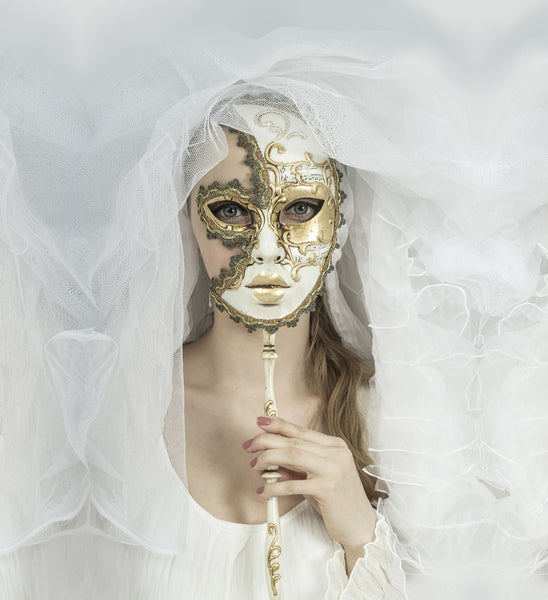The History of Masks
Posted by EVA FRANCO

As a fashion designer, the elaborate and theatrical Carnival masks, especially in the city of Venice, immediately came to my mind as I started making masks for my clients. In a normal year, Venice fills with visitors and many of them wear gorgeous Renaissance-era style costumes and masks. It’s as much a moving, street-side fashion show as it is a holiday celebration. Costumed and masked people slowly stroll around the old, cobble-stoned streets and pose for others to take their photographs.
Where some people think of masks as confining, the Venetians saw it as an opportunity to be bold. Wearing a mask during Carnival began as early as the 13th century because it was the only time of the year when people could step outside of their social class. It didn’t matter whether they were rich, poor, noble, or peasant. The colorful masks hid their identity, so the Venetians could party with anyone. Being anonymous gave them the freedom to explore, flirt, and interact with people they normally would never have approached. These same types of masks eventually made it to Louisiana’s festive Mardi Gras parade celebrations during Carnival.

The playful Venetians also experimented with colors and mask shapes to send a message to the people around them. Carnival masks take full advantage of color as a visual way to communicate everything from sensuality to confidence. A bold red mask meant that the person was willing to take risks, but also conveyed sexuality and power. Gold and silver, of course, meant prestige and elegance. Depending on the shade of green, a person could show their sporty and casual side. Blue showed off a calm personality, but also a creative one. White and black were worn to be more innocent or mysterious, as preferred.
Masks can also be used to highlight feminine features, even as they hide them. Venetian women used oval moretta masks to emphasize the softer, rounder shapes of their faces. Paired with a veil, the moretta mask made a feminine and elegant impression. On the total opposite end, the jester mask is a fun and free-spirited covering with bells as embellishments on the ends.

I love this concept of using a mask to free yourself and change your story. So many of us are at home right now and without much live interaction with other people, except through Zoom calls and social media. It’s easy to lose a sense of who you are, or more importantly, who you want to become. Take inspiration from the Venetians and use masks as a way to explore or show off a new side of yourself. Make a statement about your mood, personality, or even your attitude. Think of them as an extension of your identity, not just as accessories or protection. It’s a powerful way to take control and step outside of your comfort zone.
My masks bring this idea to life. Flirty, floral and feminine, modern and minimalist, edgy, sporty. Even though your face may be hidden, emotion, personality, and your mood for the day, can be expressed through the use of colors, style, and even the outfit you pair with your mask. Masks highlight your eyes and frame your face, perfect for working on your eye-flirt game.
Use the bright and summery hues and prints in my mask collection to express yourself. The pink medley mask brings a sense of feminine playfulness to your outfit, while you can take a more elegant approach with the dark navy floral mask, perfect for that summer evening event. Keep it cool with a casual denim look or go for that “just out with the girls” breeziness with pastels and flowers. Flower embellishments and masks that double as scarves give you options for dressing for fun or a more upscale event. Whatever your choice, use masks as a way to explore and step outside of your comfort zone. Just like the Venetians.



